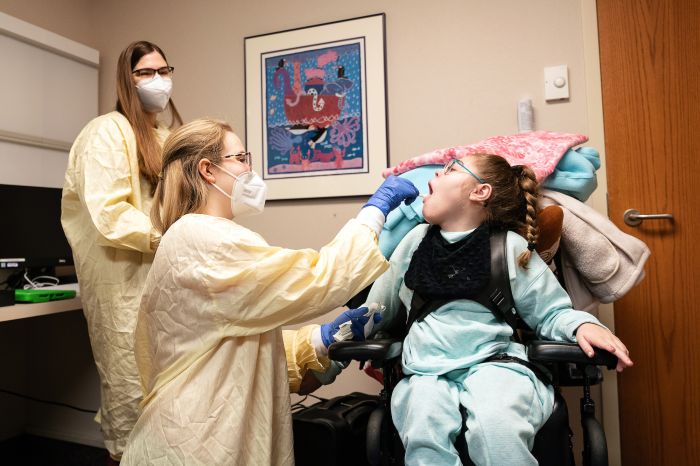To better understand postoperative pain and surgical outcomes in children who have cerebral palsy (CP), Gillette Children’s has launched the groundbreaking multisite Predictors of Pain research study. Funded by an R01 NIH grant—Gillette’s first primary R01 award—this study is led by Senior Clinical Scientist Chantel Burkitt, PhD, along with Liz Boyer, PhD, and Tom Novacheck, MD, orthopedic surgeon and Chair of Gillette Children’s Cerebral Palsy Institute. This study is conducted at Gillette as well as Nemours Children's Hospital in Delaware. The Nemours site is led by M. Wade Shrader, MD, orthopedic surgeon and current President of the American Academy for Cerebral Palsy and Developmental Medicine (AACPDM), along with Jason Howard, MD.
The Predictors of Pain study will identify predictive factors for the development of chronic postoperative pain. To do this, the study will engage 500 families over five years, focusing on children aged 5-17 who have a CP diagnosis and who are undergoing single-event, multi-level surgery or spine surgeries. The study will document the typical trajectory of perioperative and postoperative pain experience in children with CP and examine pain intensity, frequency, duration, and interference as well as sensory, physical, and emotional factors.
How Can We Measure Pain?
To ensure their data points are comprehensive, the research team will rely on online survey responses over 13 months as well as objective measures of pain collected during sensory testing, opioid use, and data collected in Gillette’s Gait & Motion Analysis Lab. Gait lab data will be essential to learning whether or not a participant’s pain affects their ability to achieve gait and mobility outcomes.
Dr. Burkitt believes one of the most important pieces of the study is the preoperative parent questionnaire. She says, “The parent responses will give researchers a baseline understanding of a patient’s pain to which they can compare all future data points.”
Dr. Novacheck believes the surveys will make all the difference to understanding how much pain his patients are experiencing. He explains, “It’s a well-documented phenomenon that people don't always completely report their pain to their doctor, especially one where there’s an ongoing relationship. I expect I will hear about more pain from these patient and family surveys than what I hear about in clinic.”
Connecting Pain and Surgical Outcomes
The questionnaires will continue throughout the patient’s surgical journey, creating a clear map of the pain trajectory in each child. Dr. Burkitt says, “Once we’ve done that, the next aim is to see how well we can predict pain outcomes and surgical outcomes based on the data collected.”
Dr. Novacheck notes that how pain relates to orthopedic outcomes has been a known issue for a long time.
“If I or one of my colleagues recommends orthopedic surgery with pain relief as one of the goals, there is nothing in the body at the time of the surgery that you can look at that says, ‘Here! I'm the pain, take me out,’” Dr. Novacheck says. “So as a clinician, when you are considering the patient history, the exam findings, the patient’s goals, and the data from this research, we want to be able to confidently characterize the pain and recommend a surgery that has a greater chance to help.”
Turning Pain Predictions into Care Guidelines
It will take time, but once the final data is evaluated, Dr. Burkitt is dreaming big about the potential uses for the study. “I'm hoping this study will give us strong, evidence-based care guidelines,” she says. “Let’s say we see a patient rating their pain a 6 out of 10 before surgery. We hope we’ll be able to confidently say to families that postponing surgery so we can work toward managing their pain to be a consistent 3 out of 10, then might mean they’ll have a stellar surgical outcome and will be more likely to meet all their postoperative goals."
While mitigating the risk factors for ongoing postoperative pain is a priority, looking even further into the future of this research, Dr. Novacheck says, “Ideally, after making those changes to our preoperative care guidelines, we can repeat this study in five, 10, 15 years and see that, yes, there is a lower percentage of patients having significant pain and pain that interferes with their function is less likely.”
Enrollment for the Predictors of Pain study is ongoing at both Gillette Children’s and Nemours. The study is expected to be fully enrolled by Summer 2027.
Get Partners in Care Stories in your inbox!
Subscribe to Partners in Care Journal, a newsletter for healthcare providers and community health professionals.
Subscribe Today Home Page
Home Page



